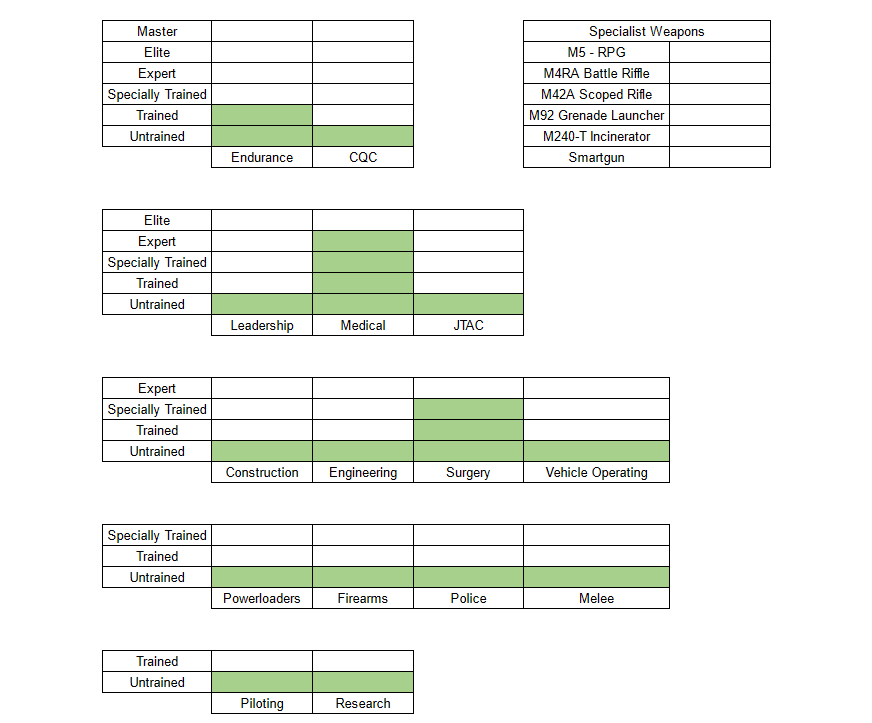 |
Difficulty: Medium Supervisors: Chief Medical Officer, Commander/Executive Officer Rank: Not defined Duties: .Research and Develop, inspect any xenobiological elements given to you by Marines. Make chemicals. Guides: Guide to Research, Guide to Chemistry, Guide to Paperwork Unlock Requirements: Not available. Detailed Description: You are a civilian, and are not subject to follow military chain of command, but you do work for the USCM. You are tasked with researching and developing new medical treatments, helping your fellow doctors, and generally learning new things. |__________| |
"I wish you could understand what we're trying to do here. The potential for this species goes way beyond urban pacification. New alloys, new vaccines. Nothing like this we've ever seen on any world before." ―Dr. Wren, Alien Resurrection
Role
The better name for this job might be "mad scientist" or "jack of all trades". In general, your job is to research and develop new technology in the science lab and study anything xenobiological. Past that, this role can be very open-ended and can be played in several ways. It's unclear whether the Researchers are MDs or PhDs, but it's doubtful anybody will get upset at you for knowing and practising medicine. Unless you're trying to interact and be helpful, it's very possible that no one will pay attention to you at all - but please don't blow the ship up or harm the crew. The Researcher is a good "swing role" to help out an over-burdened medical team or assist other departments.
When dealing with Xenomorphs, this role demands a high level of roleplay. Roleplay doesn’t include:
- “Yeah, well it makes you a host for xenomorphs.”
- “Yeah, I’ve seen this before.”
- “They’re hostile. Kill them all. Don’t worry, I can tell.”
- “Just jam it in the cage and forget it exists.”
All variations of this are also pretty horrible, so don’t do it, okay?
Chemical Research
Research has its own chemistry lab that can be used to help out medical by pumping out useful healing chemicals. It is also possible to mix chemicals together to get multiple benefits; however, be aware that there are certain chemicals which will cause more harm if they are used together. Consult the chemistry guide for more details.
Manufacturing Grenades
- Autolathe 2 large beakers (Buckets also work)
- Autolathe 1 Large Chem Grenade (it holds 2 beakers)
- Grab 1 timer and 1 igniter from an Autolathe
- Put potassium in one large beaker using the chem dispenser (Click it in your hand to use a lid)
- Put an equal amount of water into the other beaker using the sinks downstairs in the operating rooms (while moving using ladders do not hold open beakers in your hands, the contents will spill)
- Place both containers into the Large Chem Grenade shell by clicking on the shell with the beaker in your active hand
- Use a screwdriver (from Autolathe or a toolbox) on the igniter to make it ready to attach
- Use a screwdriver on the timer until it's ready to attach
- Attach that timer to the igniter; use the screwdriver on that assembly to make it "ready"
- Add the ready timer-igniter assembly to the Large Chemical Grenade by clicking on it
- Use the screwdriver to ready the grenade (it should turn green)
- Use the hand labeller to name the detonator and grenade the same thing
- DO NOT send the activate the now armed grenade unless you want to breach R&D like an idiot. Give it to a competent marine.
60 units of each potassium and water is a medium boom. 90 units of each is a serious bang.
Try out different mixes of chemicals to find more explosive and damaging reactions. Just remember that certain combinations will instantly react and should not be allowed in the same beaker. For instance, if you filled one beaker with 60u potassium and tried to add 60u of water, it'll blow up in your face.
Hydroponics Research
Note that hydroponics is currently undergoing a rework, much of the information here is subject to change.
Hydroponics is the process of growing plants without soil. The Company has provided The USS Almayer's research wing with a hydroponics laboratory. Here, researchers can grow and experiment with plant genetics.
Your Skillset
To find out about how the skill system works head over to the skills system page.














